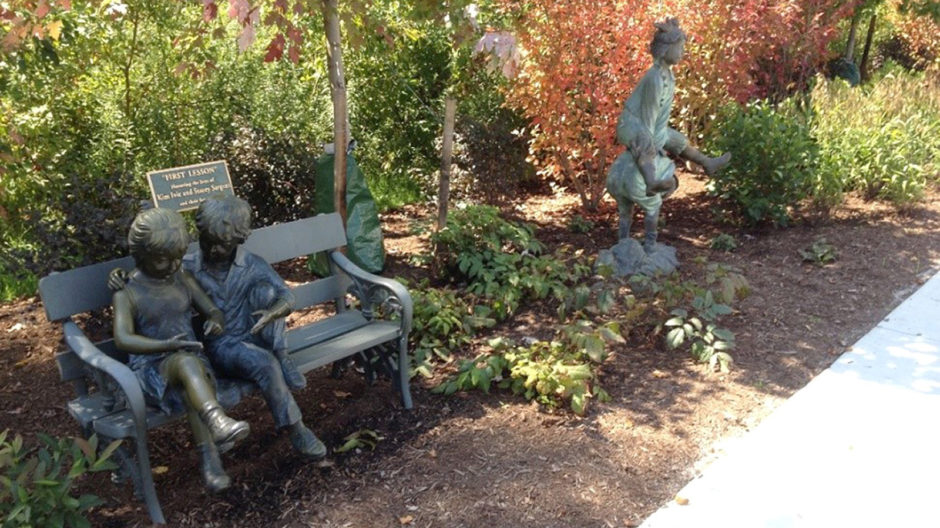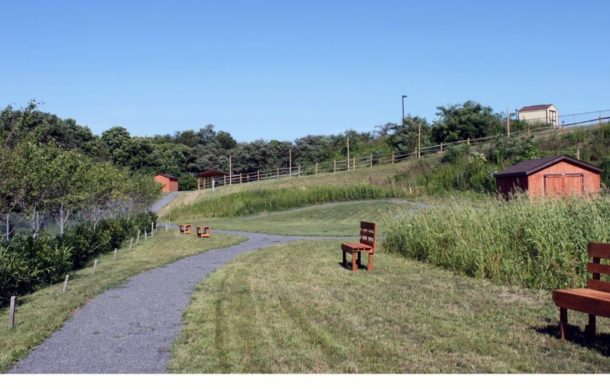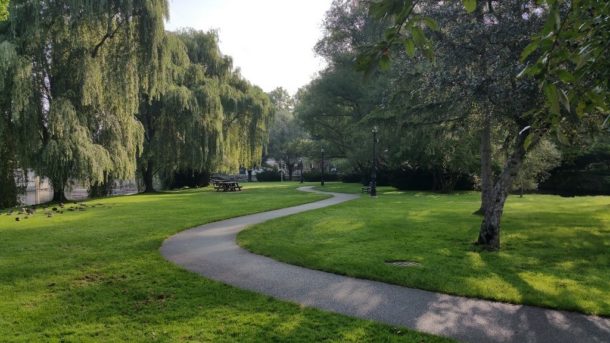Connecting with Nature: Open Space and Native Landscape Assets

I remember when I was young and played outside after school until dinner. We didn’t have cable or smart phones. However, at the end of our street, there was a giant mud puddle. Little did I realize that what we thought was one of the Great Lakes was actually a seasonal wetland. We played in that puddle for hours; skipping rocks, chasing tad poles, spreading milkweed, all the while connecting with nature in a way my geology, biology, and ecology professors would later call ‘research’. For the amount of mud tracked into my parent’s basement, I’d likely need an erosion and sedimentation control permit today.
“The native plants increase our connection to nature, help educate our neighbors, and provide a beautiful, peaceful place to relax.”
Being outside is fun
The natural environment can be challenging, stimulating, and inspiring. But today our contact with the natural environment is affected more and more by evolving regulations directed at the functional use and aesthetic control of landscapes. Landscapes are changing. According to the USDA Economic Information Bulletin No. (EIB-14) 54 pp, May 2006, the most consistent trends between 1945 and 2002 included an upward trend in special-use and urban areas, with grazing lands and forest use trending downward. Research suggests that the current generation of children often suffer from what child advocacy expert Richard Louv calls ‘nature-deficit disorder’. He believes there is a direct link between the lack of nature in the lives of today’s ‘wired’ generation and trends toward childhood obesity, attention disorders and depression. According to the Center for Disease Control (CDC):
- 8 to 18 year old adolescents spend an average of 7.5 hours a day using television, computers, video games, cell phones, movies, etc.
- The average American eats 15 more pounds of sugar a year than in 1970.
- Obesity now affects 17% of all children and adolescents in the United States – triple the rate from just one generation ago.
When children are going outside to play, the environment they experience is typically sterile and devoid of natural elements; a landscape most often defined by mulch, lawn and pavement. What green space they do find is typically drastically altered and lacking in natural features. Plantings are dominated by non-native and invasive plant species which do little to enhance their connection to nature.
Native plants nurture butterflies, bees, caterpillars, and birds, which bring life to a landscape and are well-adapted to our local ecosystems. Non-native ornamental plants tend to be free of environmental conditions that limit their range within their naturally occurring ecosystems. They are often disease- and pest-free in our own climate, making them preferred plant material in developed landscapes, but also makes them prone to naturalize and invade our native ecosystems.
Federal Executive Order 13112 (February 3, 1999) defines invasive species as a "species whose introduction causes or is likely to cause economic or environmental harm or harm to human health." Cornell researchers have determined that controlling a single invasive species can cost millions. According to Jeff Ward, chief scientist for the Department of Forestry and Horticulture at the Connecticut Agricultural Experiment Station (CAES), the prevalence of ticks infected with the Lyme disease–causing spirochete (Borrelia burgdorferi) is greater in areas with the non-native Japanese barberry than areas without. The PA DCNR characterizes invasive plants as adaptable, aggressive, and having a high reproductive capacity. Deer eat everything but barberry, making way for more barberry.

Figure 1 – The "I Wonder…’ Nature Trails at the Penn-Mont Academy Outdoor Classroom, Hollidaysburg, PA. "There must be a provision for the child to have contact with nature; to understand and appreciate the order, the harmony and the beMaria Montessori’s Visionauty in nature."
The USDA Forest Service claims that invasive species contributed to the decline of 42% of the nations endangered and threatened species and are the main cause of decline for 18% of U.S. endangered and threatened species. According to the Natural History Museum of London’s database of known host plants, no native species of Lepidoptera (moths and caterpillar) use the non-native Buddleja davidii (butterfly bush) as a food plant. If we consider the environment as an ecological system, the butterfly bush actually contributes little to the food chain of the butterfly. It invades functioning native landscapes while failing to serve, other than nectar, as a host plant that allows butterflies to feed and reproduce.
Japanese barberry (Berberis thunbergii) and the butterfly bush (Buddleja davidii) are both on the Pennsylvania Department of Conservation and Natural Resource’s list of invasive species and are readily available at your local nursery.
The benefits of using native plants also include improved wildlife habitat, maintenance of biodiversity, climatic suitability, resistance to pests and diseases, reduced water and chemical use, and reduced maintenance.
The current generation is connecting less with nature and the nature they are connecting with is typically less natural.
Most children do not have access to undeveloped landscapes. The spaces that are designed specifically for them are often highly programmed, with little opportunity to interact with natural elements. The CDC states that "American society has become characterized by environments that promote increased consumption of less healthy food and physical inactivity." Outdoor environments must be sufficiently compelling to compete with the ubiquitous digital activities that keep children indoors.
A new report from the National Wildlife Federation, Back to School: Back Outside, shows how outdoor education and time is connected with wide ranging academic benefits including:
- Increased student motivation and enthusiasm to learn
- Better performance in math, science, reading and social studies
- Improved classroom behavior and concentration
- Reduced Attention Deficit Hyperactivity Disorder (ADHD)
- Higher scores on standardized tests (including college entrance exams)
Proper design and management of open space is good for us, for nature and for the bottom line.
According to the EPA, open space is any open piece of land that is undeveloped (has no buildings or other built structures) and is accessible to the public. Open space can include schoolyards, playgrounds, public seating areas, public plazas, and vacant lots. Open space can also include green space (land that is partly or completely covered with grass, trees, shrubs, or other vegetation). Green space includes parks, community gardens, and cemeteries.
Open space, essential to quality of life in every community, needs to be recognized, stimulated and supported in order to thrive. Open space systems are a potential environmental, social and economic resource that, through design and management, can sustain and expand health and ecosystem benefits by:
- Providing a functional connection through outdoor activities and
- Enhancing biodiversity through the aesthetic use of native plants.
Landscape Architects are well-suited to play a critical role in the management of open space as an asset. Through a collaborative process they act as stewards, integrating programmatic and site requirements into cohesive land development solutions that incorporate topography, flora, fauna, climate, soil, geography, water and regulatory aspects of site planning and design.

Figure 2– Walking Trail at Talleyrand Park, Bellefonte, PA.“Walking is the most popular aerobic physical activity. Improving spaces and having safe places to walk can help more people become physically active.” CDC. (2015). More People Walk to Better Health. Retrieved July 15, 2015. http://www.cdc.gov/vitalsigns/Walking/index.html
Other open space components include circulation systems, such as campus walkways, corporate wellness paths, streetscapes; recreation trails, bikeways and greenways; stormwater features including bioswales and rain gardens; and healthcare amenities, such as healing gardens. While there is almost no limit to the possibilities, a systematic decision-making process is essential to conserving these open space systems and designing the amenities that sustain and expand the benefits of quality open space opportunities.
When developing your next project, or just planting in your backyard, consider how you are connecting to nature and the impact it has on you, your co-workers, family and friends. How are you leveraging your open space assets to promote human, as well as ecological, health and well-being?
This paper is based on remarks originally presented at the American Society of Landscape Architects, Pennsylvania – Delaware Chapter Annual Meeting on April 19th, 2013 in Rehoboth Beach, Delaware and titled “Connecting with Nature: Open Space Assets and Edible Landscape”. The draft was presented in preliminary form for AIA HSW credit at the February 2015, WMF Continuing Education session titled “Connecting with Nature: Open Space Assets and Native Landscapes”, course number C0671502A.
